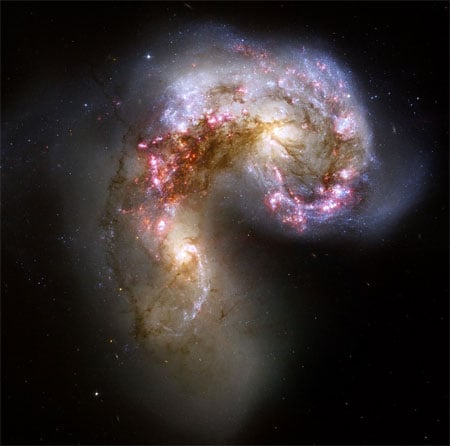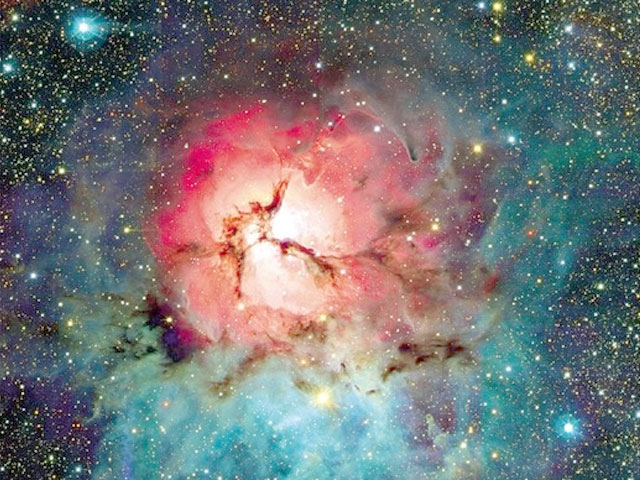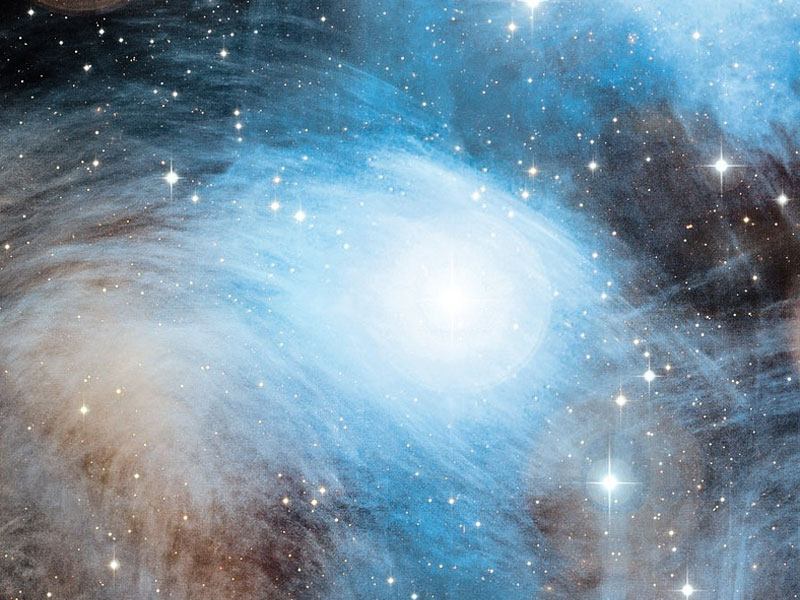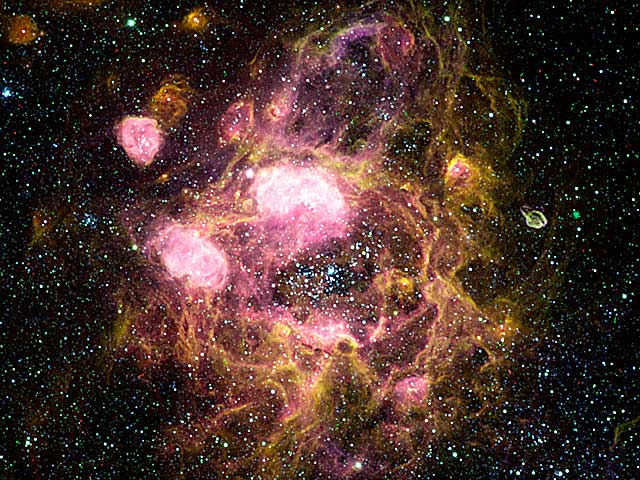|
Author
|
Topic: Cosmic Hand Reaches for the Light
|
Node
Knowflake Posts: 1438
From: Crowded House
Registered: Nov 2005
|
 posted April 12, 2009 11:40 AM
posted April 12, 2009 11:40 AM
 
 lagoon nebula heart nasa lagoon nebula heart nasa
IP: Logged |
Azalaksh
Moderator Posts: 8369
From: New Brighton, MN, USA
Registered: Nov 2004
|
 posted April 12, 2009 11:57 AM
posted April 12, 2009 11:57 AM
 
This one kind of reminds me of a T.Rex with mouth open wide   IP: Logged |
Azalaksh
Moderator Posts: 8369
From: New Brighton, MN, USA
Registered: Nov 2004
|
 posted April 12, 2009 12:06 PM
posted April 12, 2009 12:06 PM
 
The "Edge-On" galaxy.....  IP: Logged |
Azalaksh
Moderator Posts: 8369
From: New Brighton, MN, USA
Registered: Nov 2004
|
 posted April 12, 2009 12:25 PM
posted April 12, 2009 12:25 PM
 
Orion Nebula has some wonderful images.....
Can you see the bow shock wave to the upper left of center??  And some monkeybusiness with the image   IP: Logged |
26taurus
Knowflake Posts: 16563
From: *
Registered: Jun 2004
|
 posted April 12, 2009 04:14 PM
posted April 12, 2009 04:14 PM
 
 IP: Logged |
Azalaksh
Moderator Posts: 8369
From: New Brighton, MN, USA
Registered: Nov 2004
|
 posted April 12, 2009 09:50 PM
posted April 12, 2009 09:50 PM
 
Another mask for Missy Node's cosmic collection   IP: Logged |
future_uncertain
Knowflake Posts: 3252
From: ohio
Registered: Aug 2004
|
 posted April 12, 2009 09:53 PM
posted April 12, 2009 09:53 PM
 
Absolutely humbling.IP: Logged |
Azalaksh
Moderator Posts: 8369
From: New Brighton, MN, USA
Registered: Nov 2004
|
 posted April 12, 2009 09:54 PM
posted April 12, 2009 09:54 PM
 
How very, very small we are.....Asteroid trail in Centaurus ~  IP: Logged |
Azalaksh
Moderator Posts: 8369
From: New Brighton, MN, USA
Registered: Nov 2004
|
 posted April 12, 2009 09:59 PM
posted April 12, 2009 09:59 PM
 
..... like a porthole looking into another dimension..... or that light at the end of a tunnel.....  IP: Logged |
Azalaksh
Moderator Posts: 8369
From: New Brighton, MN, USA
Registered: Nov 2004
|
 posted April 12, 2009 10:11 PM
posted April 12, 2009 10:11 PM
 
LL Orionis -- bow shockwave..... it's hard to even comprehend the immense force of the shockwave from an exploding star.....  From the Reflection Nebula in the Pleiades..... it's not hard for me to imagine dancers in those cosmic "clouds".....  IP: Logged |
Azalaksh
Moderator Posts: 8369
From: New Brighton, MN, USA
Registered: Nov 2004
|
 posted April 12, 2009 10:21 PM
posted April 12, 2009 10:21 PM
 
Home Sweet Home.....   Two views of the center of the Milky Way Galaxy ~   Explanation of following picture: Inspired during a visit to Fort Davis, Texas, home of McDonald Observatory and dark night skies, photographer Larry Landolfi created this tantalizing fantasy view. The composited image suggests the Milky Way is a heavenly extension of a deserted country road. Of course, the name for our galaxy, the Milky Way (in Latin, Via Lactea), does refer to its appearance as a milky band or path in the sky. In fact, the word galaxy itself derives from the Greek for milk. Visible on moonless nights from dark sky areas, though not so colourful as in this image, the glowing celestial band is due to the collective light of myriad stars along the plane of our galaxy, too faint to be distinguished individually. The diffuse starlight is cut by dark swaths of obscuring galactic dust clouds. At the beginning of the 17th century, Galileo turned his telescope on the Milky Way and announced it to be composed of innumerable stars.  IP: Logged |
26taurus
Knowflake Posts: 16563
From: *
Registered: Jun 2004
|
 posted April 12, 2009 10:35 PM
posted April 12, 2009 10:35 PM
 
Spectacular!!! Thank you for the show Z. I LOVE that Landolfi photograph! Had never seen it before!Yes, how very small we are.....like stardust... IP: Logged |
26taurus
Knowflake Posts: 16563
From: *
Registered: Jun 2004
|
 posted April 12, 2009 10:39 PM
posted April 12, 2009 10:39 PM
 
Astronomers using the Hubble Space Telescope have snapped the most detailed image ever of a pair of colliding galaxies, known as the Antenna galaxy.The galaxies are the nearest merging pair to Earth, and the youngest too: the collision began about 500m years ago. As the two galaxies smash into one another, they create ideal conditions for new stars to be born. And new stars are forming in their billions.
 http://www.theregister.co.uk/2006/10/17/galactic_collision/ http://www.theregister.co.uk/2006/10/17/galactic_collision/
IP: Logged |
26taurus
Knowflake Posts: 16563
From: *
Registered: Jun 2004
|
 posted April 12, 2009 10:46 PM
posted April 12, 2009 10:46 PM
 
 Using ESO's Very Large Telescope, an international team of astronomers has discovered a stunning rare case of a triple merger of galaxies. This system, which astronomers have dubbed 'The Bird' - albeit it also bears resemblance with a cosmic Tinker Bell - is composed of two massive spiral galaxies and a third irregular galaxy. "Examples of mergers of three galaxies of roughly similar sizes are rare," says Petri Vaisanen, lead author of the paper reporting the results. "Only the near-infrared VLT observations made it possible to identify the triple merger nature of the system in this case."
IP: Logged |
26taurus
Knowflake Posts: 16563
From: *
Registered: Jun 2004
|
 posted April 12, 2009 11:01 PM
posted April 12, 2009 11:01 PM
 

Above is an image from a corner of the Trifid Nebula taken by the Hubble Space telescope.  
Horsehead Nebula 
Ghosthead Nebula IP: Logged |
26taurus
Knowflake Posts: 16563
From: *
Registered: Jun 2004
|
 posted April 12, 2009 11:04 PM
posted April 12, 2009 11:04 PM
 

Explanation: Unspeakable beauty and unimaginable bedlam can be found together in the Trifid Nebula. Also known as M20, this photogenic nebula is visible with good binoculars towards the constellation of Sagittarius. The energetic processes of star formation create not only the colors but the chaos. The red-glowing gas results from high-energy starlight striking interstellar hydrogen gas. The dark dust filaments that lace M20 were created in the atmospheres of cool giant stars and in the debris from supernovae explosions. Which bright young stars light up the blue reflection nebula is still being investigated. The light from M20 we see today left perhaps 3000 years ago, although the exact distance remains unknown. Light takes about 50 years to cross M20.
IP: Logged |
26taurus
Knowflake Posts: 16563
From: *
Registered: Jun 2004
|
 posted April 12, 2009 11:06 PM
posted April 12, 2009 11:06 PM
 

Explanation: Reflection nebulas reflect light from a nearby star. Many small carbon grains in the nebula reflect the light. The blue color typical of reflection nebula is caused by blue light being more efficiently scattered by the carbon dust than red light. The brightness of the nebula is determined by the size and density of the reflecting grains, and by the color and brightness of the neighboring star(s). NGC 1435, pictured above, surrounds Merope (23 Tau), one of the brightest stars in the Pleiades (M45). The Pleiades nebulosity is caused by a chance encounter between an open cluster of stars and a molecular cloud.
IP: Logged |
26taurus
Knowflake Posts: 16563
From: *
Registered: Jun 2004
|
 posted April 12, 2009 11:09 PM
posted April 12, 2009 11:09 PM
 

Explanation: How did this unusually large nebula form? One of the largest nebulas yet detected is actually a complex ring of emission nebulas connected by glowing filaments. The unusual network, known as N11, spans over 1000 light years and is a prominent structure of the Large Magellanic Cloud, the largest satellite galaxy of our Milky Way Galaxy. In the center of the above image is open star cluster LH9, also known as NGC 1760, composed of about 50 bright blue stars that emit radiation that has eroded a hole in their surroundings. A leading hypothesis for the formation of N11 is shells of successive generations of stars being formed further out from the center. The bright region just above center is N11B, an explosive domain where stars are being formed even today.
IP: Logged |
26taurus
Knowflake Posts: 16563
From: *
Registered: Jun 2004
|
 posted April 12, 2009 11:11 PM
posted April 12, 2009 11:11 PM
 


M42/M43 & NGC1977
IP: Logged |
26taurus
Knowflake Posts: 16563
From: *
Registered: Jun 2004
|
 posted April 12, 2009 11:12 PM
posted April 12, 2009 11:12 PM
 

The Sword of OrionThe 'Sword of Orion' contains a few of the most beautiful nebulae in the sky: NGC 1977 ( 'Running Man Nebula') to the left, small M43in the middle, and last -but not least - M42, the 'Great Nebula in Orion'. All of them shine in the spectral emission line of hydrogen and oxygen.
The whole complex is embedded in a huge hydrogen cloud, visible dimly red. The 'Trapezium' in the middle of the small bright patch in M42 has caved out a big hollow shell by its radiation, which excites the inner walls to glow brightly.
IP: Logged |
26taurus
Knowflake Posts: 16563
From: *
Registered: Jun 2004
|
 posted April 12, 2009 11:20 PM
posted April 12, 2009 11:20 PM
 
Nice shot of the Eagle Nebula, Z and Node.  IP: Logged |
koiflower
Knowflake Posts: 3203
From: Australia
Registered: Jun 2008
|
 posted April 13, 2009 12:58 AM
posted April 13, 2009 12:58 AM
 
Awesome!!! I love these photos. I love the Hubble for what it can do for us!!IP: Logged |
Azalaksh
Moderator Posts: 8369
From: New Brighton, MN, USA
Registered: Nov 2004
|
 posted April 13, 2009 08:47 PM
posted April 13, 2009 08:47 PM
 
Wonderful images, T  IP: Logged |
26taurus
Knowflake Posts: 16563
From: *
Registered: Jun 2004
|
 posted April 15, 2009 04:42 AM
posted April 15, 2009 04:42 AM
 
You'll love these Z. 
Starry Night, so named because it reminded astronomers of the Van Gogh painting. It is a halo of light around a star in the Milky Way 
Cat's Eye Nebula 
Cone Nebula IP: Logged |
26taurus
Knowflake Posts: 16563
From: *
Registered: Jun 2004
|
 posted April 15, 2009 04:46 AM
posted April 15, 2009 04:46 AM
 
weird. i seem to be having some technical difficulties over here.the post went through but the thread never moved up in the forum!  don't tell me i'm about to break another thread! (Node,  ) ) *edit okay, seems to be fine now. 
IP: Logged |

 Lindaland
Lindaland

 Lindaland Central
Lindaland Central

 Cosmic Hand Reaches for the Light (Page 2)
Cosmic Hand Reaches for the Light (Page 2)

